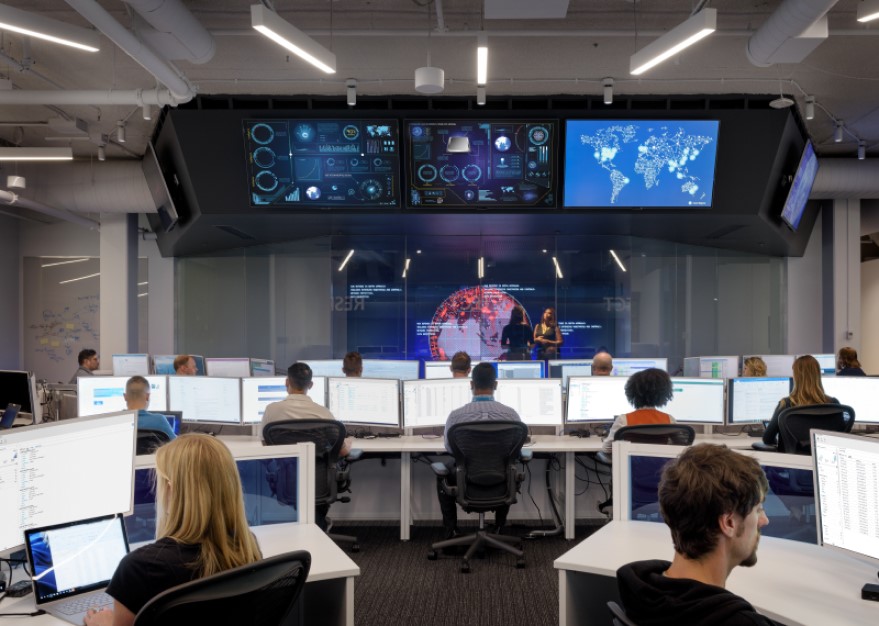
Microsoft and partners: Securing the digital subsea environment through innovation
A comprehensive approach to deliver continuous innovation to support and secure the critical underwater infrastructure.
The underwater and littoral environments remain critical to a nation’s economic interests and its ability to exploit marine resources. In addition to the traditional resources, energy production from water and wind are vital resources carried by subsea cables. These cables provide high-speed, low-cost, and reliable connections, with more than 400 cables spanning over 1.3 million kilometers across the world. They are essential for global data transmission, including the financial and digital economies.
In October 2020, NATO Defense Ministers discussed the threat to critical subsea infrastructure posed by increasing state actor capability and aggression.1 Subsea protection was renewed in 2022 by the United Kingdom Defence Chief, Admiral Sir Tony Radakin, and is a current priority by NATO in the Digital Ocean initiative.2 Subsea protection is a subject of debate across the globe spanning the Atlantic Ocean, Pacific Ocean, and European seas, which experience highly congested sea-borne infrastructures.3 Furthermore, in 2024, NATO is exploring the “Digital Ocean” as a pioneering initiative for maritime situational awareness.4
Protection of the subsea domain relies on allied defense organizations and asset operators developing and deploying innovative solutions and data-driven insights to enhance situational awareness, communication, and decision-making capabilities. However, this is a complex environment, and several technical and operational challenges need to be addressed, such as high latency, low bandwidth, power consumption, security, data quality, multi-domain sensor integration, and processing at the edge.
Transforming Sub-Surface Operations
Leverage the power of data and AI to empower the defense ecosystem

Strategies can be implemented to address these challenges by using industry-leading capabilities and integrating them with hyperscale data fabric. This collaborative effort involves working closely with allied defense organizations, coast guard, government entities, and asset operators to determine innovative ways of deploying a secure and intelligent digital backbone to safeguard critical underwater infrastructure.
Meeting the challenge
Fundamentally, meeting the operational information demands requires the ingestion, analysis, distribution, and visualization of data across the subsea domain:
- Data ingestion: Securely and reliably collect, store, and process data from various sources, such as sensors, devices, satellites, and surface links. Additionally, this may require technology and infrastructure that can operate disconnected for extended periods and with an innate ability to conduct safe, secure syncing when connectivity becomes available.
- Data analysis: Applying artificial techniques, such as anomaly detection, classification, and prediction, to data to generate actionable insights and intelligence. This may require those AI and machine learning models to be developed using high-performance computing and packaged for inferencing at the extreme edge, with processes that allow efficient deployment and an effective feedback loop.
- Data distribution: Sharing and exchanging data across different domains, platforms, and stakeholders in a timely and efficient manner while respecting data governance, together with the ability to support interoperability standards (such as Standardization Agreements [STANAGs], CATL, and others) and also meeting the challenge of denied, degraded, intermitted, and latent network requirements while maintaining security policies.
- Data visualization: Presenting and displaying the data and insights in a user-friendly and intuitive way, such as dashboards, holographic displays, geospatial data infrastructure, and charts to support situational awareness and enhance decision-making.
Meeting the challenges is a significant undertaking and requires a flexible, modular, and interoperable solution. That solution must support and adapt to the dynamic and complex underwater environment, while meeting security requirements and the priorities of allied defense organizations and industry partners.
Therefore, we aim to support the construction of a common reference architecture for a test and development environment based on the principles of a digital software factory. This will enable the implementation and underpin the sustainment of a machine learning ecosystem for an interoperable, underwater infrastructure in support for continuous innovation at speed and at scale.
A proposed solution
At the core, there are four principles of design to help ensure security and intelligence in an underwater environment. They include:
- Hyperscale compute at scale in the cloud and at the edge to enable secure information operations that extends cloud services to the edge, providing a trusted collaboration environment for a wide range of infrastructure partners. The provision of a hyperscale environment also meets the ongoing needs for security, scalability, and reliability.
- Secure data exchange to support a Zero Trust, multi-domain network of asset operations and sensors, while maintaining security and data controls. A secure data exchange capability also meets the operational requirements for trusted data and information sharing across a complex ecosystem of agencies and public and private infrastructures within a multi-dimensional legal framework that cross the boundaries of territorial waters.
- Ubiquitous connectivity through terrestrial and non-terrestrial networks, leveraging current infrastructures at scale and meeting the asymmetric growth in data volume and near real-time data insights. Furthermore, we envision the (future) application of private 5G and satellite backhaul connecting sensors at subsurface, surface, and above surface that enhance risk management and reduce mitigation at sea.
- Assurance and risk management services for the maritime and energy sectors combining the requirement for public and private partnerships in current and future energy infrastructure.
Applying these design principles provides a comprehensive solution for a secure undersea digital backbone. It will:
- Enable enhanced situational awareness for all parties across the operating landscape.
- Facilitate data sharing and exchange across domains, platforms, and stakeholders.
- Ensure security and reliability across the infrastructure and environment.
- Optimize the performance and operations through the provision of undersea digital services for the maritime, energy, and defense sectors.
Ultimately, delivering enhanced human-machine teaming in military and non-military operations provides the backbone for computational decision-assist capabilities that are data-driven, trusted, and transparent.
Enhance maritime operations with Microsoft solutions
The domain of critical underwater infrastructure is a strategic and challenging environment that requires cloud-enabled innovative and interoperable capabilities to enhance data and network management for undersea operations.
Microsoft for Defense and Intelligence believes this approach will provide a comprehensive and flexible solution that delivers significant benefits for situational awareness, communication, collaboration, security, reliability, performance, as well as efficiency of undersea operations and the critical infrastructure situated in the maritime environment.
For more insights, read the “Transforming Sub-Surface Operations with Data-Driven Decision Support” whitepaper.
Empowering militaries. Improving operations. Protecting national security.
1NATO seeks ways of protecting undersea cables from Russian attacks, Euractiv.
2Chief of Defence Staff: Russia cutting underwater cables could be ‘an act of war, Froces.net.
3Australia must do more to secure the cables that connect the Indo-Pacific, ASPI Strategist.




